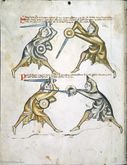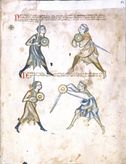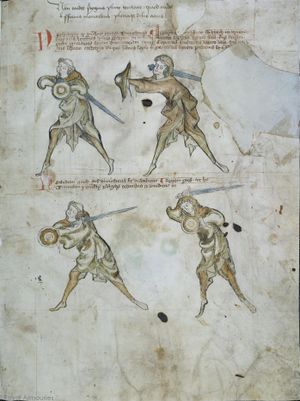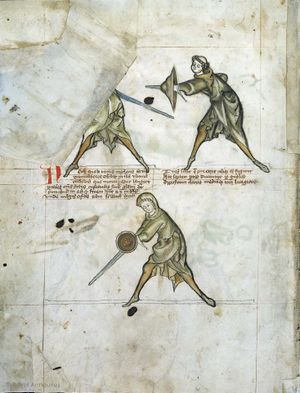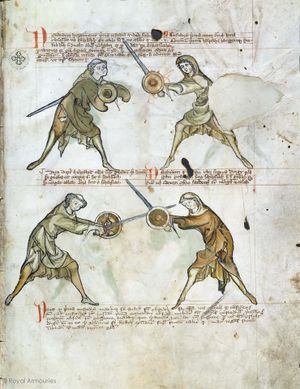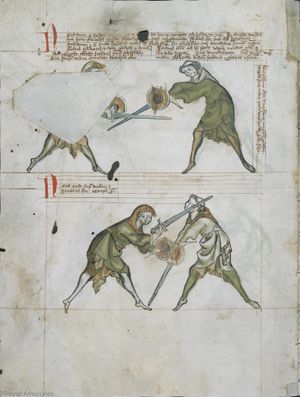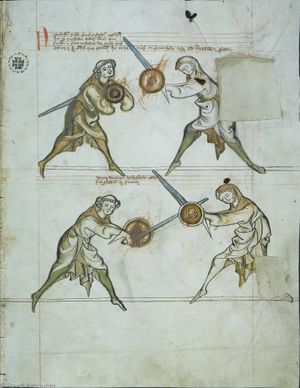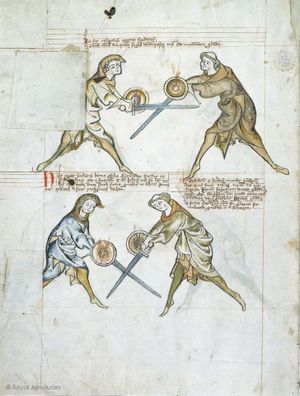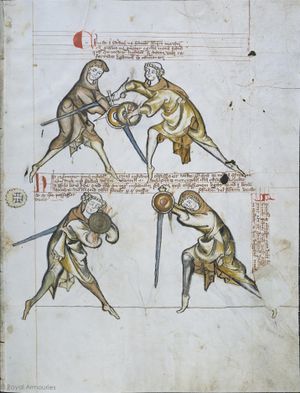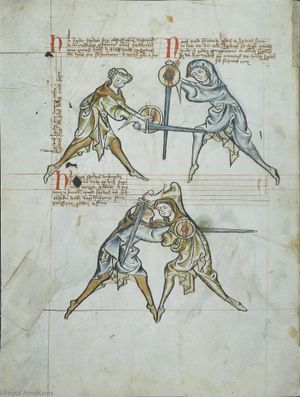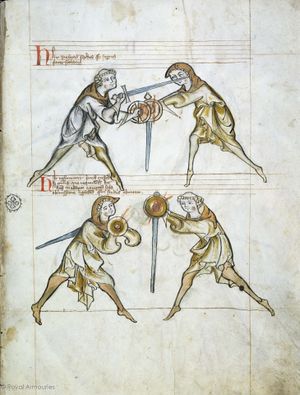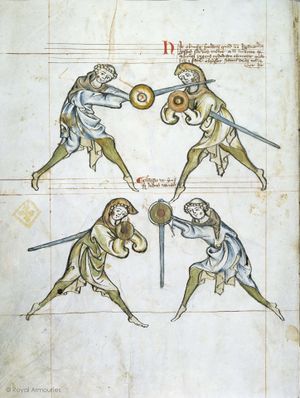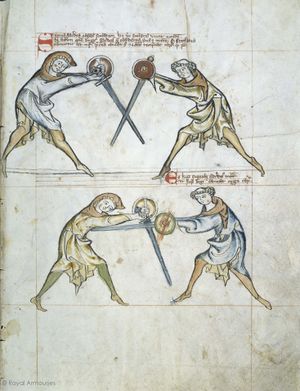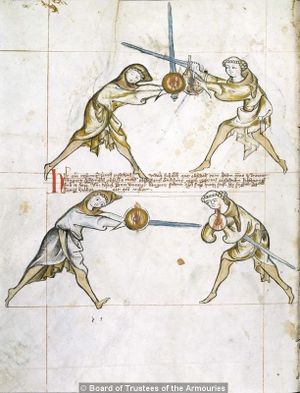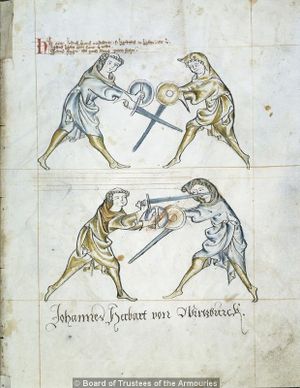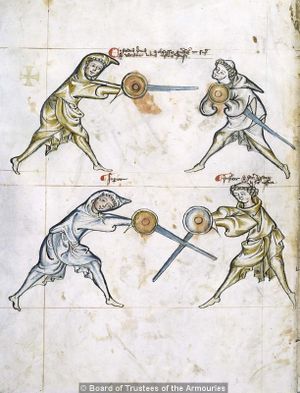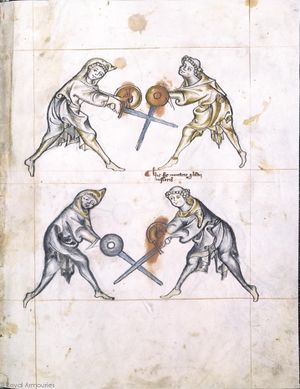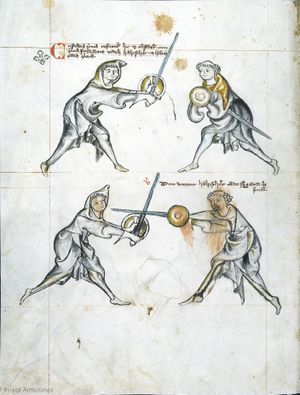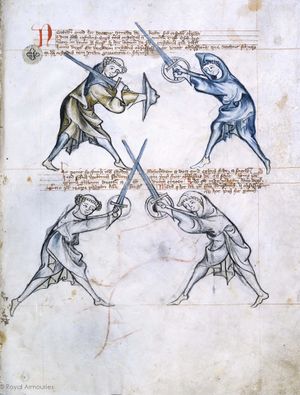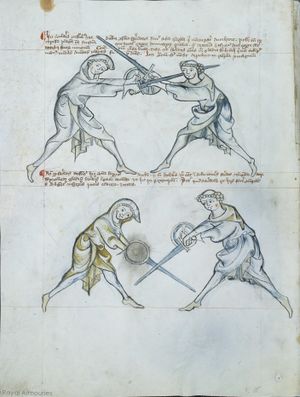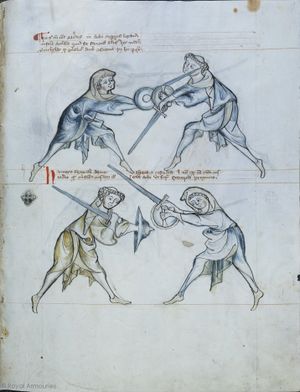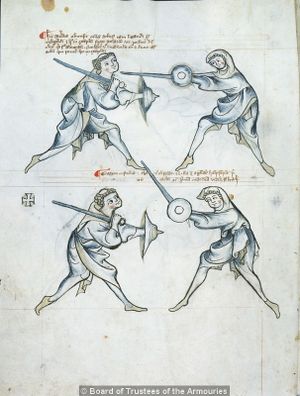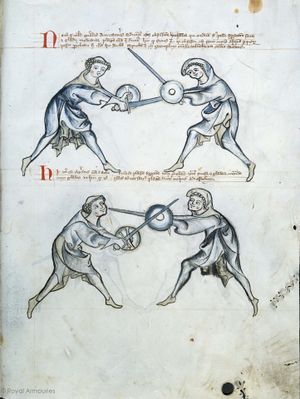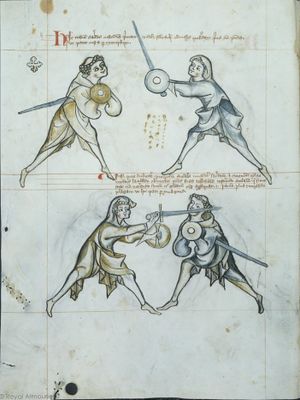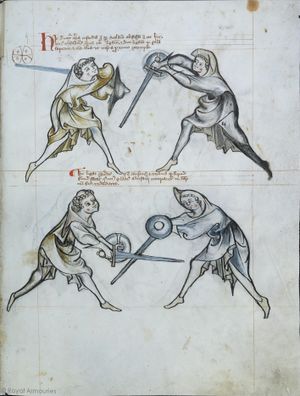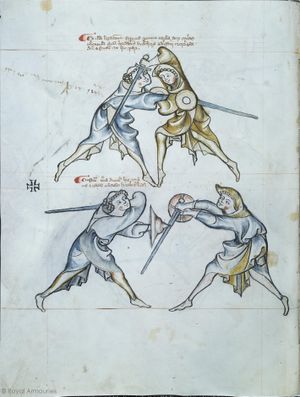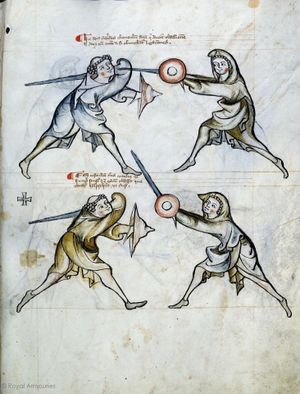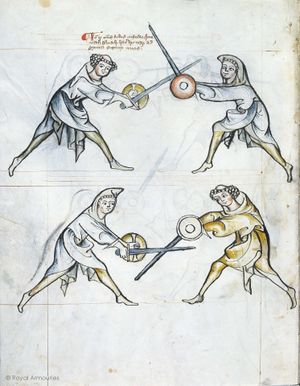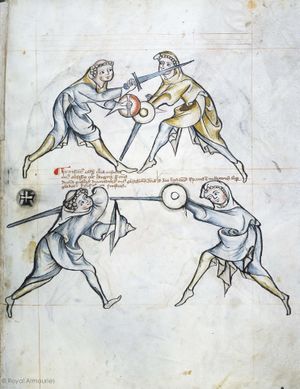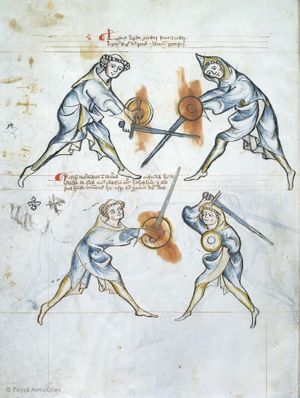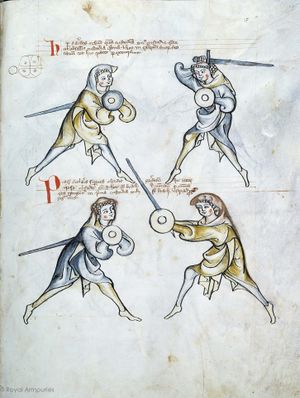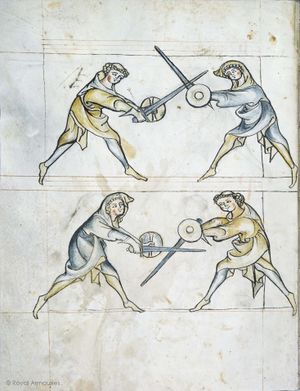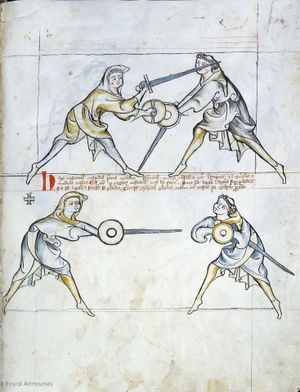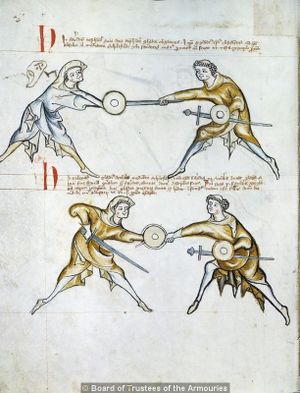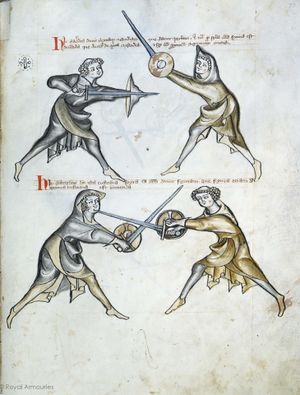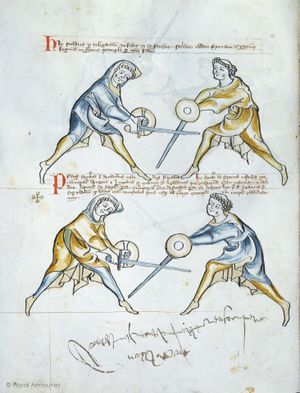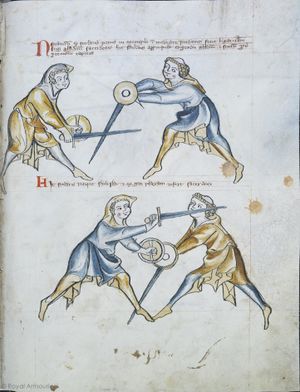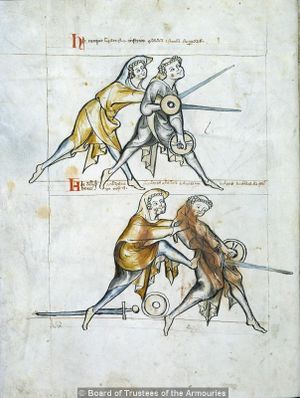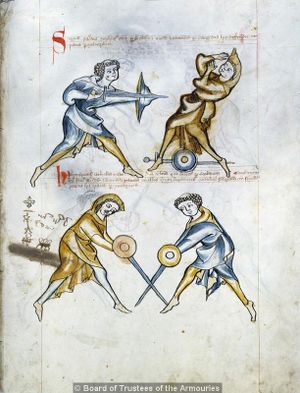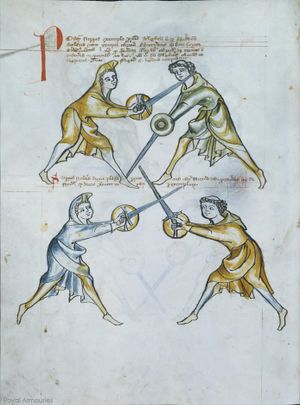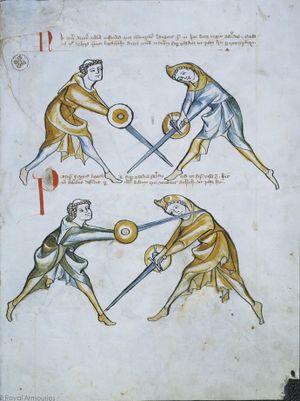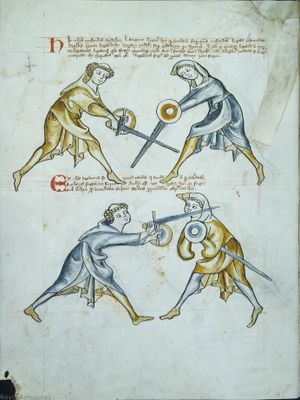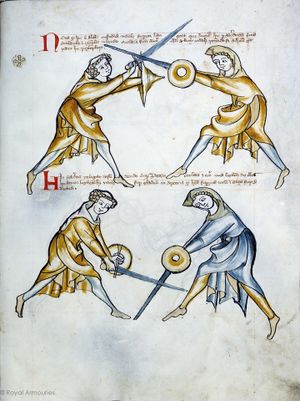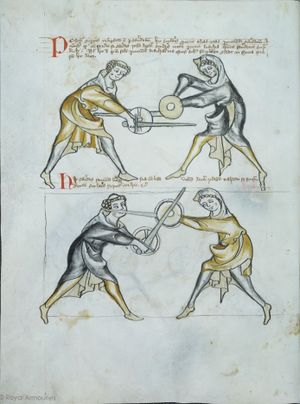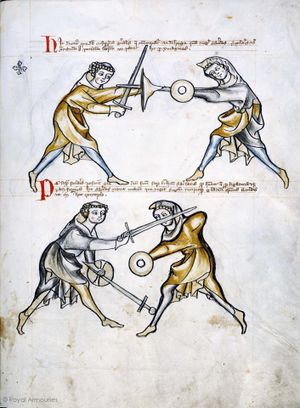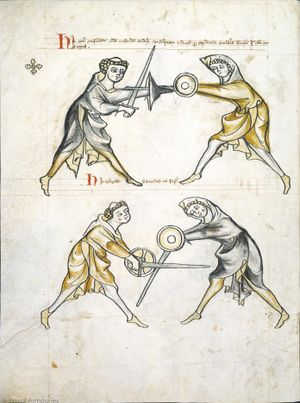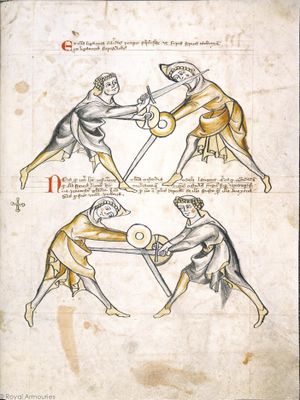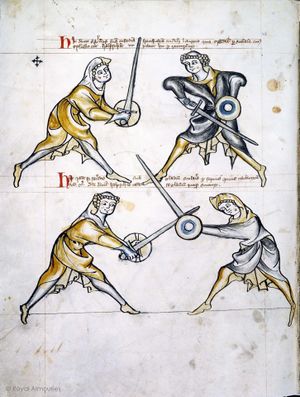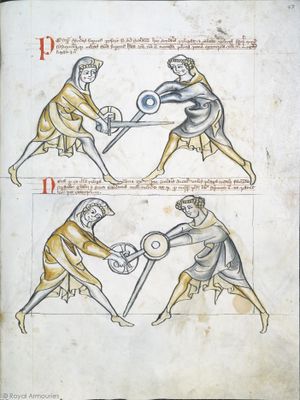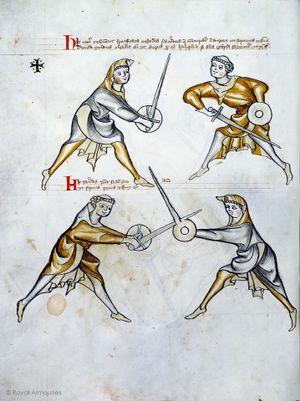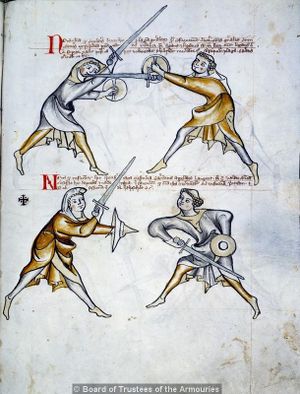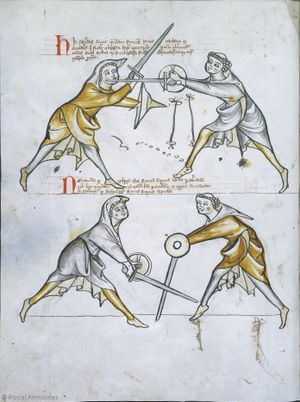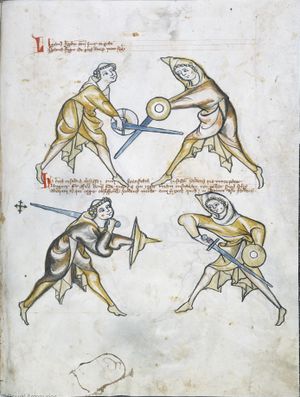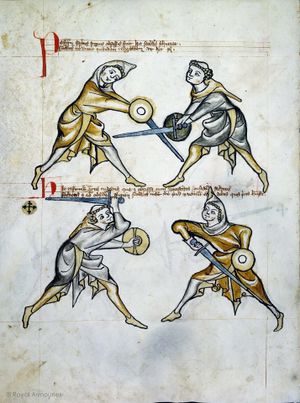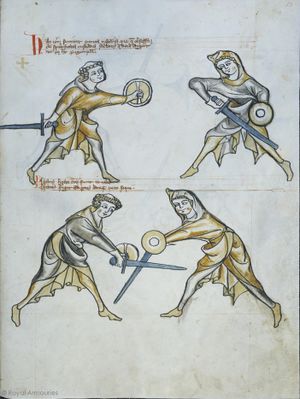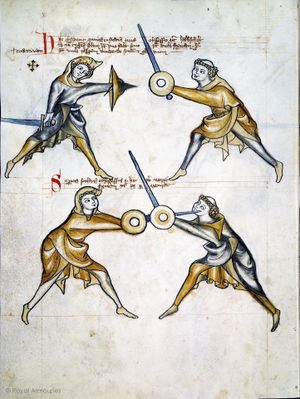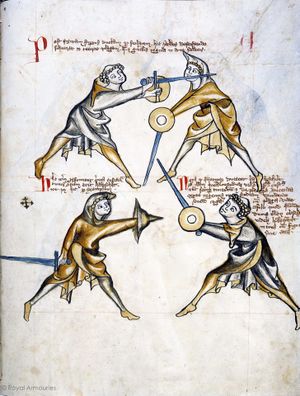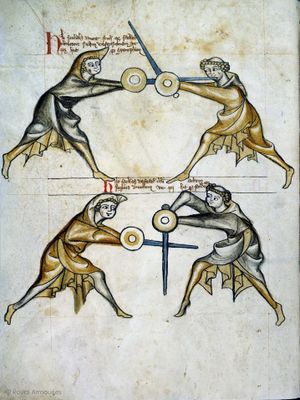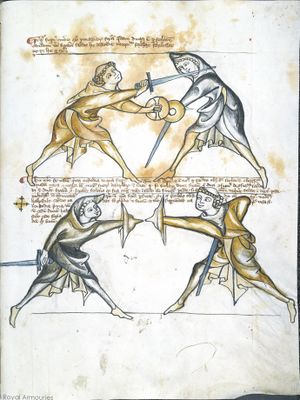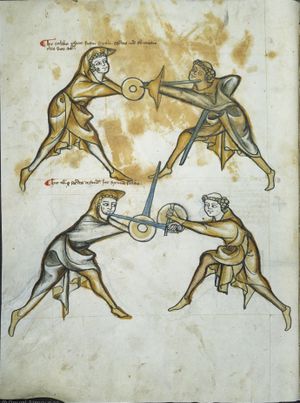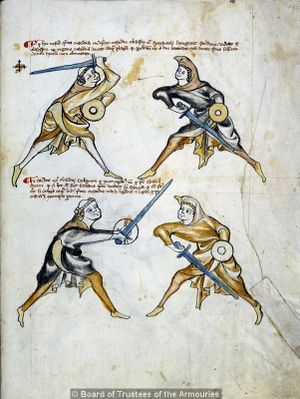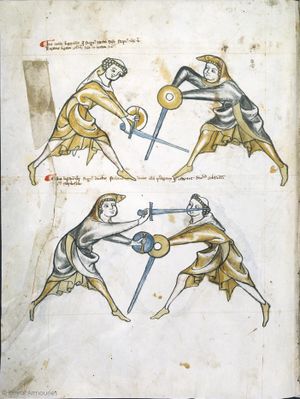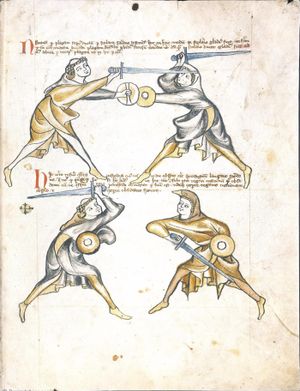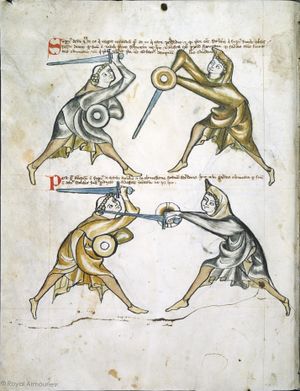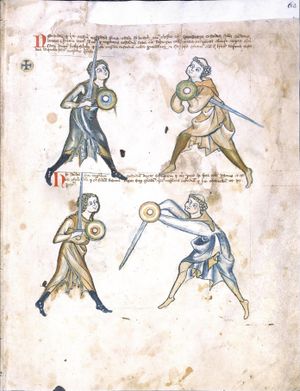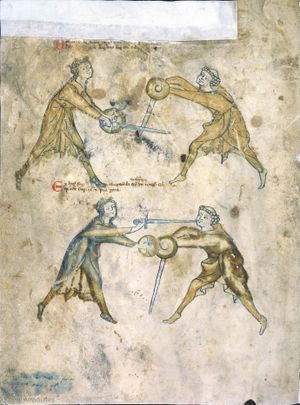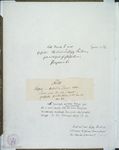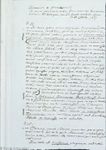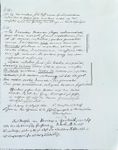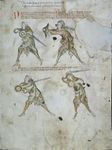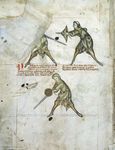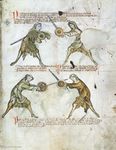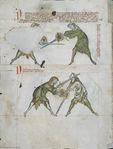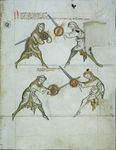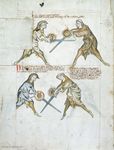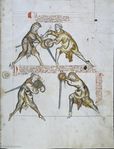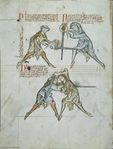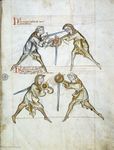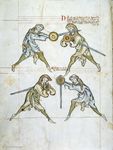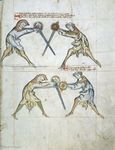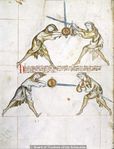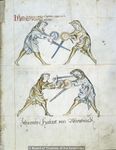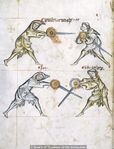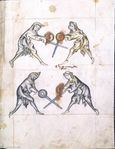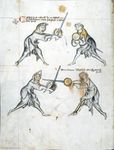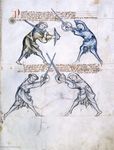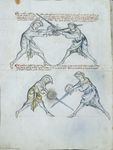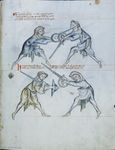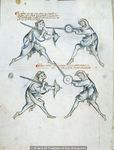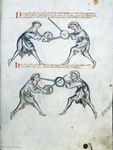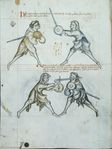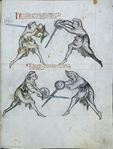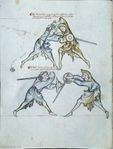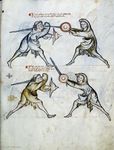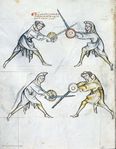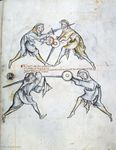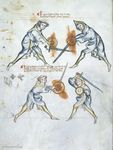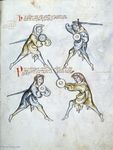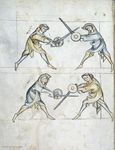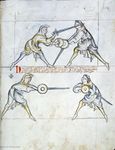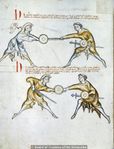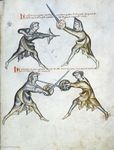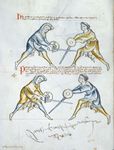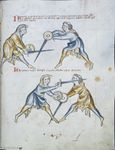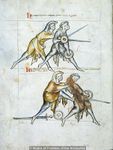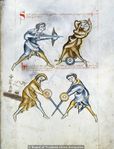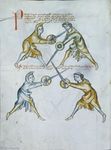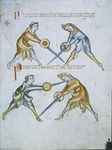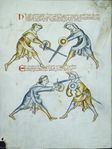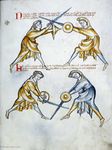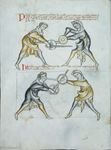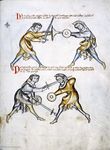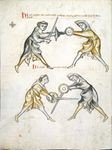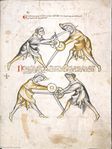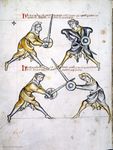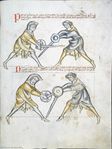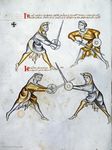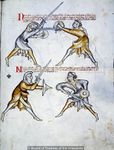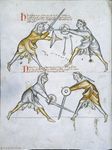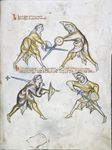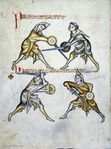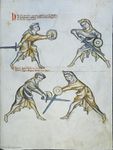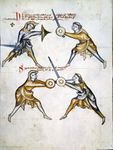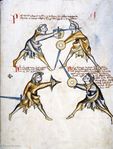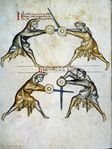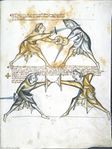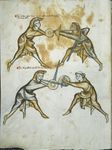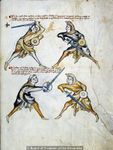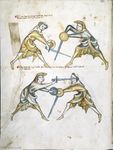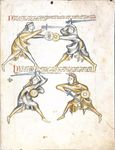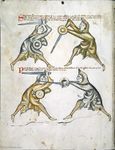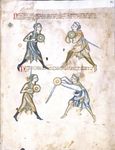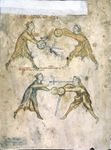|
|
You are not currently logged in. Are you accessing the unsecure (http) portal? Click here to switch to the secure portal. |
Difference between revisions of "Walpurgis Fechtbuch (MS I.33)"
| Line 118: | Line 118: | ||
|- | |- | ||
| rowspan="4" | [[File:MS I.33 2r.jpg|300px|center|Folio 2r]] | | rowspan="4" | [[File:MS I.33 2r.jpg|300px|center|Folio 2r]] | ||
| − | | <p>[7] (+)''' It is to be seen that here is the first ward contained, i.e. the one under the arm, and the displacer is in ''halpschilt''. I give the good counsel that the one (assuming the ward) under the arm do not execute a strike, which is commendable from the ''albersleiben'', for the reason that he could not reach the upper part, and (reaching anywhere) lower would be pernicious to the head. But the displacer entering to attack may reach him at any time if he fails to observe what is written below:</p> | + | | <p>[7] '''(+)''' It is to be seen that here is the first ward contained, i.e. the one under the arm, and the displacer is in ''halpschilt''. I give the good counsel that the one (assuming the ward) under the arm do not execute a strike, which is commendable from the ''albersleiben'', for the reason that he could not reach the upper part, and (reaching anywhere) lower would be pernicious to the head. But the displacer entering to attack may reach him at any time if he fails to observe what is written below:</p> |
| {{section|Page:MS I.33 02r.jpg|1|lbl=2r}} | | {{section|Page:MS I.33 02r.jpg|1|lbl=2r}} | ||
| Line 164: | Line 164: | ||
|- | |- | ||
| rowspan="2" | [[File:MS I.33 3r.jpg|300px|center]] | | rowspan="2" | [[File:MS I.33 3r.jpg|300px|center]] | ||
| − | | <p>[17] (+)''' It is to be seen how the first ward is again assumed, because of certain actions of this first section, i.e. because of the first ward that was treated first. But all things that belong here you will find on the first page, up to the mutation of the sword.</p> | + | | <p>[17] '''(+)''' It is to be seen how the first ward is again assumed, because of certain actions of this first section, i.e. because of the first ward that was treated first. But all things that belong here you will find on the first page, up to the mutation of the sword.</p> |
| {{section|Page:MS I.33 03r.jpg|1|lbl=3r}} | | {{section|Page:MS I.33 03r.jpg|1|lbl=3r}} | ||
| Line 194: | Line 194: | ||
|- | |- | ||
| − | | <p>[24] (+)''' {{red|H}}ere the first ward is re-assumed, to which ward the displacement will be very rare, because none uses to apply it save the priest or his clients, i.e. his students, and this displacement is called ''krucke'', and I counsel in good faith that the one executing the ward should bind immediately after the displacement, because it is not good to tarry, or that he should do aught by which he may be saved, or that he should immediately do that, which his displacer does.</p> | + | | <p>[24] '''(+)''' {{red|H}}ere the first ward is re-assumed, to which ward the displacement will be very rare, because none uses to apply it save the priest or his clients, i.e. his students, and this displacement is called ''krucke'', and I counsel in good faith that the one executing the ward should bind immediately after the displacement, because it is not good to tarry, or that he should do aught by which he may be saved, or that he should immediately do that, which his displacer does.</p> |
| {{section|Page:MS I.33 04r.jpg|2|lbl=-}} | | {{section|Page:MS I.33 04r.jpg|2|lbl=-}} | ||
| Line 224: | Line 224: | ||
|- | |- | ||
| − | | <p>[31] (+)''' Here the first ward is re-assumed, but all that is necessary you have here in it, except only the omission of the binding, which the pupil omits.</p> | + | | <p>[31] '''(+)''' Here the first ward is re-assumed, but all that is necessary you have here in it, except only the omission of the binding, which the pupil omits.</p> |
| {{section|Page:MS I.33 05r.jpg|2|lbl=-}} | | {{section|Page:MS I.33 05r.jpg|2|lbl=-}} | ||
| Line 233: | Line 233: | ||
|- | |- | ||
| − | | <p>[33] (+)''' Displacement as before, but the game is varied.</p> | + | | <p>[33] '''(+)''' Displacement as before, but the game is varied.</p> |
| {{section|Page:MS I.33 05v.jpg|2|lbl=-}} | | {{section|Page:MS I.33 05v.jpg|2|lbl=-}} | ||
| Line 247: | Line 247: | ||
|- | |- | ||
| rowspan="2" | [[File:MS I.33 6v.jpg|300px|center|Folio 6v]] | | rowspan="2" | [[File:MS I.33 6v.jpg|300px|center|Folio 6v]] | ||
| − | | <p>[36] (+)''' Here the first ward is re-assumed, namely the one under the arm, which is displaced with a certain counter that is called ''langort'', and it is a common displacement, and the counters to this displacement are, for the part of the one assuming the ward, bindings above and below,</p> | + | | <p>[36] '''(+)''' Here the first ward is re-assumed, namely the one under the arm, which is displaced with a certain counter that is called ''langort'', and it is a common displacement, and the counters to this displacement are, for the part of the one assuming the ward, bindings above and below,</p> |
| {{section|Page:MS I.33 06v.jpg|1|lbl=6v}} | | {{section|Page:MS I.33 06v.jpg|1|lbl=6v}} | ||
| Line 269: | Line 269: | ||
|- | |- | ||
| rowspan="2" | [[File:MS I.33 7v.jpg|300px|center|Folio 7v]] | | rowspan="2" | [[File:MS I.33 7v.jpg|300px|center|Folio 7v]] | ||
| − | | <p>[41] (+)''' First ward and common displacement as above, but the game varies at the end of the passage.</p> | + | | <p>[41] '''(+)''' First ward and common displacement as above, but the game varies at the end of the passage.</p> |
| {{section|Page:MS I.33 07v.jpg|1|lbl=7v}} | | {{section|Page:MS I.33 07v.jpg|1|lbl=7v}} | ||
| Line 286: | Line 286: | ||
|- | |- | ||
| rowspan="2" | [[File:MS I.33 8v.jpg|300px|center|Folio 8v]] | | rowspan="2" | [[File:MS I.33 8v.jpg|300px|center|Folio 8v]] | ||
| − | | <p>[44] (+)''' The first ward is re-assumed and displaced by the first displacement, namely ''halpschilt'', and you will have all of the above.</p> | + | | <p>[44] '''(+)''' The first ward is re-assumed and displaced by the first displacement, namely ''halpschilt'', and you will have all of the above.</p> |
| {{section|Page:MS I.33 08v.jpg|1|lbl=8v}} | | {{section|Page:MS I.33 08v.jpg|1|lbl=8v}} | ||
| Line 300: | Line 300: | ||
|- | |- | ||
| rowspan="2" | [[File:MS I.33 9r.jpg|300px|center|Folio 9r]] | | rowspan="2" | [[File:MS I.33 9r.jpg|300px|center|Folio 9r]] | ||
| − | | <p>[46] (+)''' It can be seen how here is taught in which way the second ward may be displaced. And I say the second ward, because the third ward which is given to the left shoulder, does not differ much from the second. But here we speak of the second ward, which is given to the right shoulder. And from the same ward, the displacer executes the displacement called ''schutzen'', because every ward has its protection (which is the meaning of ''schutzen'').</p> | + | | <p>[46] '''(+)''' It can be seen how here is taught in which way the second ward may be displaced. And I say the second ward, because the third ward which is given to the left shoulder, does not differ much from the second. But here we speak of the second ward, which is given to the right shoulder. And from the same ward, the displacer executes the displacement called ''schutzen'', because every ward has its protection (which is the meaning of ''schutzen'').</p> |
| {{section|Page:MS I.33 09r.jpg|1|lbl=9r}} | | {{section|Page:MS I.33 09r.jpg|1|lbl=9r}} | ||
| Line 322: | Line 322: | ||
|- | |- | ||
| − | | <p>[51] (+)''' "the second to the right shoulder", i.e. the second ward. And note, that both the one assuming the ward and the one displacing it are in the same position as in the previous example.</p> | + | | <p>[51] '''(+)''' "the second to the right shoulder", i.e. the second ward. And note, that both the one assuming the ward and the one displacing it are in the same position as in the previous example.</p> |
| {{section|Page:MS I.33 10r.jpg|2|lbl=-}} | | {{section|Page:MS I.33 10r.jpg|2|lbl=-}} | ||
| Line 331: | Line 331: | ||
|- | |- | ||
| − | | <p>[53] (+)''' same ward, but with a different displacement, and it is the one called ''halbschilt'' first treated displacing the first ward, i.e. the one under the arm.</p> | + | | <p>[53] '''(+)''' same ward, but with a different displacement, and it is the one called ''halbschilt'' first treated displacing the first ward, i.e. the one under the arm.</p> |
| {{section|Page:MS I.33 10v.jpg|2|lbl=-}} | | {{section|Page:MS I.33 10v.jpg|2|lbl=-}} | ||
| Line 345: | Line 345: | ||
|- | |- | ||
| rowspan="2" | [[File:MS I.33 11v.jpg|300px|center|Folio 11v]] | | rowspan="2" | [[File:MS I.33 11v.jpg|300px|center|Folio 11v]] | ||
| − | | <p>[56] (+)''' Here the priest re-adopts the first ward, i.e. the one under the arm; some things were omitted which you had not put before, as shown in the example below.</p> | + | | <p>[56] '''(+)''' Here the priest re-adopts the first ward, i.e. the one under the arm; some things were omitted which you had not put before, as shown in the example below.</p> |
| {{section|Page:MS I.33 11v.jpg|1|lbl=11v}} | | {{section|Page:MS I.33 11v.jpg|1|lbl=11v}} | ||
| Line 354: | Line 354: | ||
|- | |- | ||
| rowspan="2" | [[File:MS I.33 12r.jpg|300px|center|Folio 12r]] | | rowspan="2" | [[File:MS I.33 12r.jpg|300px|center|Folio 12r]] | ||
| − | | <p>[58] (+)''' Here, the priest adopts third ward, which is displaced by the student as shown. The counter to this displacement will be a bind, and I say bind, but only above, and no other as in the example below.</p> | + | | <p>[58] '''(+)''' Here, the priest adopts third ward, which is displaced by the student as shown. The counter to this displacement will be a bind, and I say bind, but only above, and no other as in the example below.</p> |
| {{section|Page:MS I.33 12r.jpg|1|lbl=12r}} | | {{section|Page:MS I.33 12r.jpg|1|lbl=12r}} | ||
| Line 376: | Line 376: | ||
|- | |- | ||
| − | | <p>[63] (+) | + | | <p>[63] ‘‘‘(+)’’’ The same third ward, viz. on the left shoulder, and the same displacement called ''halbschilt'', as above.</p> |
| {{section|Page:MS I.33 13r.jpg|2|lbl=-}} | | {{section|Page:MS I.33 13r.jpg|2|lbl=-}} | ||
| Line 386: | Line 386: | ||
|- | |- | ||
| [[File:MS I.33 14r.jpg|300px|center|Folio 14r]] | | [[File:MS I.33 14r.jpg|300px|center|Folio 14r]] | ||
| − | | <p>[65] (+) | + | | <p>[65] ‘‘‘(+)’’’ Here the third ward is re-adopted, which will be displaced by ''langort'', which all common fencers execute, and the counter to this displacement are two binds, one on the right above the sword, the other on the left.</p> |
| {{section|Page:MS I.33 14r.jpg|1|lbl=14r}} | | {{section|Page:MS I.33 14r.jpg|1|lbl=14r}} | ||
| Line 397: | Line 397: | ||
|- | |- | ||
| − | | <p>[67] (+) | + | | <p>[67] ‘‘‘(+)’’’ Now that the third ward has been treated, here the fourth is treated, which will have ''halbschilt'' as its displacement, and all that you had before you will find here up to the next sign of the cross.</p> |
| {{section|Page:MS I.33 14v.jpg|2|lbl=-}} | | {{section|Page:MS I.33 14v.jpg|2|lbl=-}} | ||
| Line 405: | Line 405: | ||
|- | |- | ||
| rowspan="2" | [[File:MS I.33 15r.jpg|300px|center|Folio 15r]] | | rowspan="2" | [[File:MS I.33 15r.jpg|300px|center|Folio 15r]] | ||
| − | | <p>[68] (+) | + | | <p>[68] ‘‘‘(+)’’’ Here the priest re-adopts the fourth ward; the displacement of this fourth ward will be the first ward, and this as an example to his pupils, as here shown in the example.</p> |
| {{section|Page:MS I.33 15r.jpg|1|lbl=15r}} | | {{section|Page:MS I.33 15r.jpg|1|lbl=15r}} | ||
| Line 419: | Line 419: | ||
|- | |- | ||
| [[File:MS I.33 16r.jpg|300px|center|Folio 16r]] | | [[File:MS I.33 16r.jpg|300px|center|Folio 16r]] | ||
| − | | <p>[70] (+) | + | | <p>[70] ‘‘‘(+)’’’ Here the first ward is re-adopted, viz. under the arm, and its displacement will be ''langort'', and it is common and of limited value, and note that he who adopts the ward has three possibilities: firstly, he may bind right, above the sword; secondly, he may left, below the sword; thirdly, he may grip the sword with his hand, as shown below in the next example.</p> |
| {{section|Page:MS I.33 16r.jpg|1|lbl=16r}} | | {{section|Page:MS I.33 16r.jpg|1|lbl=16r}} | ||
| Line 436: | Line 436: | ||
|- | |- | ||
| rowspan="2" | [[File:MS I.33 17r.jpg|300px|center|Folio 17r]] | | rowspan="2" | [[File:MS I.33 17r.jpg|300px|center|Folio 17r]] | ||
| − | | <p>[73] (+) | + | | <p>[73] ‘‘‘(+)’’’ Here the priest adopts the sixth ward, which is given to the breast. And note, it is solely this stab that must be executed which is executed from the fifth ward, up to the next sign of the cross.</p> |
| {{section|Page:MS I.33 17r.jpg|1|lbl=17r}} | | {{section|Page:MS I.33 17r.jpg|1|lbl=17r}} | ||
| Line 449: | Line 449: | ||
|- | |- | ||
| − | | <p>[76] (+) | + | | <p>[76] ‘‘‘(+)’’’ After all the wards above have been treated, here the seventh ward is treated, which is called ''langort'', and note that there are four binds, that answer to this ward, namely two from the right, and the other two from the left. But here we speak only of the first bind above the sword, which you have all in the first ward, up to the fourth example, where sword and shield are taken.</p> |
| {{section|Page:MS I.33 17v.jpg|2|lbl=-}} | | {{section|Page:MS I.33 17v.jpg|2|lbl=-}} | ||
| Line 476: | Line 476: | ||
|- | |- | ||
| − | | <p>[82] (+) | + | | <p>[82] ‘‘‘(+)’’’ Here the same final ward is adopted by the pupil. The priest counters, and it is one of the four binds, namely the one below and left, as shown in the images.</p> |
| {{section|Page:MS I.33 19r.jpg|2|lbl=-}} | | {{section|Page:MS I.33 19r.jpg|2|lbl=-}} | ||
| Line 496: | Line 496: | ||
|- | |- | ||
| rowspan="2" | [[File:MS I.33 20r.jpg|300px|center|Folio 20r]] | | rowspan="2" | [[File:MS I.33 20r.jpg|300px|center|Folio 20r]] | ||
| − | | <p>[86] (+) | + | | <p>[86] ‘‘‘(+)’’’ Here the final ward is again adopted, which is called ''langort'', and here the priest is adopting it. But the pupil executes one of the four binds, viz. above the sword, as shown here in the example.</p> |
| {{section|Page:MS I.33 20r.jpg|1|lbl=20r}} | | {{section|Page:MS I.33 20r.jpg|1|lbl=20r}} | ||
| Line 505: | Line 505: | ||
|- | |- | ||
| rowspan="2" | [[File:MS I.33 20v.jpg|300px|center|Folio 20v]] | | rowspan="2" | [[File:MS I.33 20v.jpg|300px|center|Folio 20v]] | ||
| − | | <p>[88] (+) | + | | <p>[88] ‘‘‘(+)’’’ Here the final ward is adopted, viz. ''langort'', by the pupil. Above this ward, the priest binds with one of the four binds, viz. above the sword and to the right. And note that whenever there is a bind, the bound may flee from the binder to wherever he likes, to the left or to the right. Thence you may diligently see that if he flees, you will follow him, as in the verse: The bound flees to the side, I try to follow.</p> |
:{{red|''Binder and bound are adverse and irate;<br/>The bound flees to the side, I try to follow.''}} | :{{red|''Binder and bound are adverse and irate;<br/>The bound flees to the side, I try to follow.''}} | ||
| Line 516: | Line 516: | ||
|- | |- | ||
| rowspan="2" | [[File:MS I.33 21r.jpg|300px|center|Folio 21r]] | | rowspan="2" | [[File:MS I.33 21r.jpg|300px|center|Folio 21r]] | ||
| − | | <p>[90] (+) | + | | <p>[90] ‘‘‘(+)’’’ Note that this is a different ward, viz. upper ''langort'' which is adopted here by the priest as an example to his pupils, and he instructs his pupil to execute this action, viz. to position himself as shown here in the example.</p> |
| {{section|Page:MS I.33 21r.jpg|1|lbl=21r}} | | {{section|Page:MS I.33 21r.jpg|1|lbl=21r}} | ||
| Line 534: | Line 534: | ||
|- | |- | ||
| rowspan="2" | [[File:MS I.33 22r.jpg|300px|center|Folio 22r]] | | rowspan="2" | [[File:MS I.33 22r.jpg|300px|center|Folio 22r]] | ||
| − | | <p>[94] (+) | + | | <p>[94] ‘‘‘(+)’’’ Here a common ward is adopted, which is called ''vidilpoge'',<ref>''vidilpoge'' = "fiddle-bow".</ref> executed by the priest. The pupil counters it positioning himself as shown here in the images.</p> |
| {{section|Page:MS I.33 22r.jpg|1|lbl=22r}} | | {{section|Page:MS I.33 22r.jpg|1|lbl=22r}} | ||
| Line 543: | Line 543: | ||
|- | |- | ||
| rowspan="2" | [[File:MS I.33 22v.jpg|300px|center|Folio 22v]] | | rowspan="2" | [[File:MS I.33 22v.jpg|300px|center|Folio 22v]] | ||
| − | | <p>[96] (+) | + | | <p>[96] ‘‘‘(+)’’’ Here the same ward is re-adopted, viz. ''vidilpoge'', executed by the priest, the pupil acting as above.</p> |
| {{section|Page:MS I.33 22v.jpg|1|lbl=22v}} | | {{section|Page:MS I.33 22v.jpg|1|lbl=22v}} | ||
| Line 556: | Line 556: | ||
|- | |- | ||
| − | | <p>[99] (+) | + | | <p>[99] ‘‘‘(+)’’’ Note that the final ward is re-adopted, viz. ''langort'', concerning which it should be noted that a stab is executed, by means of which the one in the ward is stabbed in the belly, i.e. he is penetrated by the sword, and note that of this paragraph not more than these two images are shown, which was the fault of the painter.<ref>''fingitur for figitur; fuit vicium pictoris'': Here is evidence that the author is not identical with the draftsman.</ref></p> |
| {{section|Page:MS I.33 23r.jpg|2|lbl=-}} | | {{section|Page:MS I.33 23r.jpg|2|lbl=-}} | ||
|- | |- | ||
| rowspan="3" | [[File:MS I.33 23v.jpg|300px|center|Folio 23v]] | | rowspan="3" | [[File:MS I.33 23v.jpg|300px|center|Folio 23v]] | ||
| − | | <p>[100] (+) | + | | <p>[100] ‘‘‘(+)’’’ Here, the priest adopts his special ward, viz. ''langort'', which is displaced by the pupil, whose displacement will be ''halpschilt'', as shown here in the example.</p> |
| {{section|Page:MS I.33 23v.jpg|1|lbl=23v}} | | {{section|Page:MS I.33 23v.jpg|1|lbl=23v}} | ||
| Line 587: | Line 587: | ||
|- | |- | ||
| rowspan="2" | [[File:MS I.33 24v.jpg|300px|center|Folio 24v]] | | rowspan="2" | [[File:MS I.33 24v.jpg|300px|center|Folio 24v]] | ||
| − | | <p>[105] (+) | + | | <p>[105] ‘‘‘(+)’’’ Here the special ward of the priest's is re-adopted, which is called ''langort'', as seen above, and again the pupil displaces it with ''haloschilt'', as above, but other examples follow, as shown below.</p> |
| {{section|Page:MS I.33 24v.jpg|1|lbl=24v}} | | {{section|Page:MS I.33 24v.jpg|1|lbl=24v}} | ||
| Line 600: | Line 600: | ||
|- | |- | ||
| − | | <p>[108] (+) | + | | <p>[108] ‘‘‘(+)’’’ Note, that here again the special ward of the priest is assumed that is called ''langort'', but it is a very strange displacement that is depicted here, and very rare, and you must know that this can be reduced to the first ward and to the displacement called ''halpschilt'' etc.</p> |
| {{section|Page:MS I.33 25r.jpg|2|lbl=-}} | | {{section|Page:MS I.33 25r.jpg|2|lbl=-}} | ||
| Line 621: | Line 621: | ||
|- | |- | ||
| − | | <p>[112] (+) | + | | <p>[112] ‘‘‘(+)’’’ Here, the third ward is displaced by the special ward of the priest's that is called ''langort'', and I counsel in good faith, that he who is performing the third ward should not at all delay his actions, because otherwise the one performing the priest's displacement will enter with a stab, which is a common practice of the priest's.</p> |
| {{section|Page:MS I.33 26r.jpg|2|lbl=-}} | | {{section|Page:MS I.33 26r.jpg|2|lbl=-}} | ||
| Line 630: | Line 630: | ||
|- | |- | ||
| − | | <p>[114] (+) | + | | <p>[114] ‘‘‘(+)’’’ Here the fourth ward is assumed again, and it is displaced by the special ward of the priest. It is now up to the priest to displace, and the pupil enters as above, and all the actions that you had before will follow.</p> |
| {{section|Page:MS I.33 26v.jpg|2|lbl=-}} | | {{section|Page:MS I.33 26v.jpg|2|lbl=-}} | ||
|- | |- | ||
| rowspan="2" | [[File:MS I.33 27r.jpg|300px|center|Folio 27r]] | | rowspan="2" | [[File:MS I.33 27r.jpg|300px|center|Folio 27r]] | ||
| − | | <p>[115] (+) | + | | <p>[115] ‘‘‘(+)’’’ Here again the fifth ward is assumed, and it is displaced by the special ward of the priest that is called ''langort'', as shown in the example.</p> |
| {{section|Page:MS I.33 27r.jpg|1|lbl=27r}} | | {{section|Page:MS I.33 27r.jpg|1|lbl=27r}} | ||
| Line 644: | Line 644: | ||
|- | |- | ||
| rowspan="2" | [[File:MS I.33 27v.jpg|300px|center|Folio 27v]] | | rowspan="2" | [[File:MS I.33 27v.jpg|300px|center|Folio 27v]] | ||
| − | | <p>[117] (+) | + | | <p>[117] ‘‘‘(+)’’’ Here the fifth ward is displaced, its displacement being ''halbschilt''. And note, that the one executing the ward may do only two things: Firstly, he can execute a stab, secondly, he can execute a strike to divide shield and sword.</p> |
| {{section|Page:MS I.33 27v.jpg|1|lbl=27v}} | | {{section|Page:MS I.33 27v.jpg|1|lbl=27v}} | ||
| Line 657: | Line 657: | ||
|- | |- | ||
| − | | <p>[120] (+) | + | | <p>[120] ‘‘‘(+)’’’ Here the fifth ward is resumed which will be countered by ''halpschilt'' as shown in the example.</p> |
| {{section|Page:MS I.33 28r.jpg|2|lbl=-}} | | {{section|Page:MS I.33 28r.jpg|2|lbl=-}} | ||
| Line 679: | Line 679: | ||
|- | |- | ||
| − | | <p>[125] (+) | + | | <p>[125] ‘‘‘(+)’’’ Here the fifth ward is again resumed, of which much was said above, and it is to be noted that the priest is displacing the pupil with a displacement that is rare and very good, as an example for his students. And you have to know, that if the pupil executes a stab, which to execute is usually the use, the priest also must execute a stab against the stab of the pupil, because his will be more effective, entering with the left foot. But if he does not want to enter he should nevertheless retract his right foot and not omit this stab. But if the pupil displaces against him by means of ''halpscilt'', the priest should fall below sword and shield, and then will follow those things which were seen before.</p> |
| {{section|Page:MS I.33 29r.jpg|2|lbl=-}} | | {{section|Page:MS I.33 29r.jpg|2|lbl=-}} | ||
| Line 699: | Line 699: | ||
|- | |- | ||
| rowspan="2" | [[File:MS I.33 30r.jpg|300px|center|Folio 30r]] | | rowspan="2" | [[File:MS I.33 30r.jpg|300px|center|Folio 30r]] | ||
| − | | <p>[129] (+) | + | | <p>[129] ‘‘‘(+)’’’ It is to be seen that here the fourth ward is again assumed, and the displacement to this fourth ward is the special ''langort'' of the priest. But the displacer should see that the one assuming the ward does not execute a strike, as it would be dangerous to tarry; therefore he should execute schuzin, and finally not omit a stab.</p> |
| {{section|Page:MS I.33 30r.jpg|1|lbl=30r}} | | {{section|Page:MS I.33 30r.jpg|1|lbl=30r}} | ||
| Line 723: | Line 723: | ||
|- | |- | ||
| − | | <p>[134] (+) | + | | <p>[134] ‘‘‘(+)’’’ Here, the fourth ward is reassumed, whose displacement is the special ''langort'' of the priest. And it is to be noted, that whenever the game is set in this way, I counsel the one assuming the ward, and also the one displacing him, that none should delay what they have to do, i.e. on one hand the one assuming the ward, a displacement, on the other hand the one displacing, a stab.</p> |
| {{section|Page:MS I.33 31r.jpg|2|lbl=-}} | | {{section|Page:MS I.33 31r.jpg|2|lbl=-}} | ||
| Line 737: | Line 737: | ||
|- | |- | ||
| rowspan="2" | [[File:MS I.33 32r.jpg|300px|center|Folio 32r]] | | rowspan="2" | [[File:MS I.33 32r.jpg|300px|center|Folio 32r]] | ||
| − | | <p>[137] (+) | + | | <p>[137] ‘‘‘(+)’’’ It is to be seen, that the first ward is reassumed, i.e. the one below the arm, the replacement to which is the special second ward of the priest on the right shoulder, and take note, that the one assuming the ward will ''schuzin'' without delay, otherwise his opponent will execute ''halbschilt'' which would be disastrous for the one assuming the ward. And from here will be generated all the things related to the first ward that were treated in the first quire.</p> |
| {{section|Page:MS I.33 32r.jpg|1|lbl=32r}} | | {{section|Page:MS I.33 32r.jpg|1|lbl=32r}} | ||
Revision as of 00:47, 29 August 2017
| Walpurgis Fechtbuch | |||||
|---|---|---|---|---|---|
| MS I.33, Royal Armouries Leeds, United Kingdom | |||||
| |||||
| |||||
| Also known as |
| ||||
| Type | Fencing manual | ||||
| Date | ca. 1320s | ||||
| Place of origin | Franconia | ||||
| Language(s) | Medieval Latin | ||||
| Ascribed to | Clerus Lutegerus | ||||
| Scribe(s) | Unknown (three hands) | ||||
| Illustrator(s) | Unknown (up to 17 artists) | ||||
| Material | Parchment, in a modern binding | ||||
| Size | 34 folia | ||||
| Format | Double-sided; two illustrations per side with text above and below | ||||
| Script | Bastarda | ||||
| Previously kept | MS Membr.I 115, Schloß Friedenstein | ||||
| Treatise scans |
Digital scans (600x800)
| ||||
| Other translations | |||||
The MS I.33 is a German fencing manual dating to the 1320s.[1] It currently rests in the holdings of the Royal Armouries at Leeds, United Kingdom. The I.33 is earliest extant treatise on Medieval martial arts, and it appears to have been devised by a secular priest, possibly the "Lutegerus" (or Liutger) mentioned in the text.[2] It was the work of three scribes and potentially as many as 17 illustrators.[3]
The treatise is fully illustrated, and consists of both mnemonic verses and longer explanations in a vernacular Medieval Latin. (The format of verse and gloss may indicate that the priest was explaining a much older tradition.) It treats unarmored fencing with sword and buckler; the intriguing fact that the fencers depicted are a priest and a student (and on the last two pages, a priest and a woman identified as St. Walpurga), seems to suggest that this was a middle class or priestly art rather than one of the knightly class. Repeatedly, the text makes mention of the pupils (scolaris/discipulus) of the priest, as well as youths (iuvenis) and clients (clientulum). It seems, therefore, to have been prepared for secular priests who were offering fencing lessons to young men.
The manuscript in its present form consists of five quires, of which all but the first are incomplete; at least eight leaves are believed to be missing (assuming it started with complete quires of four bifolia each).[3] The precise contents of these missing leaves are unknown, but it is possible that they were a source for the thirty uncaptioned sword and buckler plays which appear in the Libri Picture A 83, the Codex I.6.2º.4, and the Cgm 3712; alternatively, these may originate from another manuscript in the same tradition. The anonymous plays seem in turn to have been the primary source for Paulus Hector Mair's treatment of the side sword and buckler, which he captioned with his own interpretations.
Contents
Provenance
The known provenance of the MS I.33 is:
- Written in the 1320s, possibly by a priest named Liutger; owned by Franconian monks until the 1500s.
- 1400s – an additional couplet was inscribed at the top of folio 1r, possibly by Enea Silvio Piccolomini (Pope Pius II; 1405-1464).[citation needed]
- 1552-53 – looted from a monastery by Johannes Herbart von Würzburg during the Franconian campaigns of Albert-Archibald, Duke of Brandenburg-Kulmbach.[4][3] Würzburg was a belt-maker by trade and later served as fencing master to the dukes of Sachsen-Gotha; he inscribed his name on folio 7r.
- before 1579 – possibly duplicated by Heinrich von Gunterrodt while compiling material for his book[4] (such a copy is currently unknown).
- late 1500s-1945 – owned by the dukes of Sachsen-Gotha; listed in an 18th century library catalog as Cod.Membr.I.no.115.[citation needed] The second device on folio 26r was copied into the Codex Guelf 125.16 Extravagante in the 1600s by a scribe who couldn't decipher the Latin text.[5] The manuscript was further described on six leaves of paper (with short excerpts of the text) by Heinrich Niewöhner in 1910. (Lost during World War II.)
- 1945-1950 – location unknown (sold London, Sotheby's, 27 March 1950). Sotheby's listed the manuscript as "a 14th-century manuscript of unknown provenance", and it was not identified as the lost Cod.Membr.I.no.115. until Krämer in 1975.[6]
- 1950-1996 – held by the Royal Armouries and stored in the Tower of London; known variously as "Tower of London Ms. I.33" or "British Museum No. 14 E iii, No. 20, D. vi. I".
- 1996 – moved to the newly-opened Royal Armouries Museum in Leeds.
Contents
| 1r - 32v |
| ||||||||||||||||||||||||||||||||||||||||||||||||||||||||||||||||||||||||||||||||||||||||||||||||||||||||||||||||||||||||||||||||||||||||||||||||||||||||||||||||||||||||||||||||||||||||||||||||||||||||||||||||||||||||||||||||||||||||||||||||||||||||||||||||||||||||||||||||||||||||||||||||||||||||||||||||||||||||||||||||||||||||||||||||||||||||||||||||||||||||||
|---|---|---|---|---|---|---|---|---|---|---|---|---|---|---|---|---|---|---|---|---|---|---|---|---|---|---|---|---|---|---|---|---|---|---|---|---|---|---|---|---|---|---|---|---|---|---|---|---|---|---|---|---|---|---|---|---|---|---|---|---|---|---|---|---|---|---|---|---|---|---|---|---|---|---|---|---|---|---|---|---|---|---|---|---|---|---|---|---|---|---|---|---|---|---|---|---|---|---|---|---|---|---|---|---|---|---|---|---|---|---|---|---|---|---|---|---|---|---|---|---|---|---|---|---|---|---|---|---|---|---|---|---|---|---|---|---|---|---|---|---|---|---|---|---|---|---|---|---|---|---|---|---|---|---|---|---|---|---|---|---|---|---|---|---|---|---|---|---|---|---|---|---|---|---|---|---|---|---|---|---|---|---|---|---|---|---|---|---|---|---|---|---|---|---|---|---|---|---|---|---|---|---|---|---|---|---|---|---|---|---|---|---|---|---|---|---|---|---|---|---|---|---|---|---|---|---|---|---|---|---|---|---|---|---|---|---|---|---|---|---|---|---|---|---|---|---|---|---|---|---|---|---|---|---|---|---|---|---|---|---|---|---|---|---|---|---|---|---|---|---|---|---|---|---|---|---|---|---|---|---|---|---|---|---|---|---|---|---|---|---|---|---|---|---|---|---|---|---|---|---|---|---|---|---|---|---|---|---|---|---|---|---|---|---|---|---|---|---|---|---|---|---|---|---|---|---|---|---|---|---|---|---|---|---|---|---|---|---|---|---|---|---|---|---|---|---|---|---|---|---|---|---|---|---|---|---|---|---|---|---|---|---|---|
Gallery
Identification and placement of missing leaves based on work by Dr. Jeffrey L. Forgeng[citation needed] and James Hester.[3] These scans are licensed under the terms of the Royal Armouries Non-Commercial Image Licence.
Additional Resources
- Binard, Fanny and Jaquet, Daniel. "Investigation on the collation of the first Fight book (Leeds, Royal Armouries, Ms I.33)". Acta Periodica Duellatorum 4(1): 3-21. 2016. doi:10.1515/apd-2016-0001.
- Cinato, Franck and Surprenant, André (in French). Le Livre de l'art du Combat: Liber de arte dimicatoria. Édition critique du Royal Armouries MS. I.33, collection Sources d'Histoire Médiévale nº39. Paris: CNRS Editions, 2009. ISBN 978-2-271-06757-9
- Dawson, Timothy. "The Walpurgis Fechtbuch: An Inheritance of Constantinople?" Arms & Armour 6(1):79-92. April 2009. doi:10.1179/174962609X417536
- Forgeng, Jeffrey L. The Illuminated Fightbook Royal Armouries Manuscript I.33. Extraordinary Editions, 2012.
- Forgeng, Jeffrey L. The Medieval Art of Swordsmanship: A Facsimile & Translation of Europe's Oldest Personal Combat Treatise, Royal Armouries MS I.33 (Royal Armouries Monograph). Chivalry Bookshelf, 2003. ISBN 1-891448-38-2
- Hester, James. "A Few Leaves Short of a Quire: Is the ‘Tower Fechtbuch’ Incomplete?" Arms & Armour 9(1):20-25. April 2012. doi:10.1179/1741612411Z.0000000003
- Hester, James. "Home-Grown Fighting: A Response to the Argument for a Byzantine Influence on MS I.33". Arms & Armour 9(1):76-84. April 2012. doi:10.1179/1741612411Z.0000000008
- Kellett, Rachel E. "Royal Armouries MS I.33: The Judicial Combat and the Art of Fencing in Thirteenth- and Fourteenth- Century German Literature". Oxford German Studies 41(1):32-56. April 1012. doi:10.1179/0078719112Z.0000000003
- Morini, Andrea and Rudilosso, Riccardo (in Italian). Manoscritto I.33. Rome: Il Cerchio Iniziative Editoriali, 2012.
References
- ↑ The manuscript has received a wide variety of dates. Anglo (1988) dated it to "the very end of the 13th century" and Hils (1985) to the early 14th century; Cinato and Surprenant (2009) are even less precise, placing it at around the turn of the 14th century. Most recent analysis has suggested a slightly later date, with Leng (2008) dating it to 1320-1330 and Hester (2012) to "around 1320".
- ↑ See folio 1v.
- ↑ 3.0 3.1 3.2 3.3 Hester (2012).
- ↑ 4.0 4.1 von Gunterrodt, Heinrich. De Veris Principiis Artis Dimicatorie. Wittenberg, 1579. p C3rv
- ↑ See Codex Guelf 125.16.Extrav., f 45r.
- ↑ S. Krämer. "Verbleib unbekannt Angeblich verschollene und wiederaufgetauchte Handschriften." Zeitschrift für Deutsches Altertum und Deutsche Literatur, volume 104. 1975
- ↑ The introductory verse was added on the upper margin of the page. According to [Forgeng], it is attributed to Aenas Sylvius (later pope Pius II; 1405-64). It is obviously referring to other sorts of unmonkish behaviour, but it seems to underline the unusual nature of fencing monks and women.
- ↑ lutegerus: presumably the name of the author / sacerdos: Liutger.
- ↑ This verse is open to disputation. Most likely, quoque combines sword and shield into a unity; sub seems to refer to a lower bind, as halpschilt threatens a blow from above. The same situation is depicted 8v and 23v. That a binding between sword and shield is not intended becomes clear on fol. 11r, where exactly that move is deprecated.
- ↑ diligenter intell...: seems unclear to me; either the instructions, that one should not hesitate should be understood diligently, or the diligence with which the adversary will judge one's actions is stressed.
- ↑ ligans ligati: One would expect *ligans ligatusque vel. sim. (plural subject). Literally, the translation would be "The binder of the bound - they are...", or "The binder; the bound ones are...". But I believe my translation correctly renders the intended meaning.
- ↑ fugit ad partes laterum: refers to side-stepping, i.e. taking into account the 3rd dimension not rendered in the images.
- ↑ The text has been re-traced in darker ink, according to CS by hand C (but closely following the original ductus of hand A).
- ↑ recipere plagam: to execute (not to receive) a blow. Probably intended as 'receive the opportunity to strike'.
- ↑ durchtritt: a step to the side seems intended; for the (preferable) action depicted, we would expect 'to the left', so dexteram may be taking the opponent's view.
- ↑ 16.0 16.1 dampnum for damnum
- ↑ vidilpoge = "fiddle-bow".
- ↑ fingitur for figitur; fuit vicium pictoris: Here is evidence that the author is not identical with the draftsman.
- ↑ Concerning the name of the woman fencer: The name walprgis as written directly above the word sac'dos (below which are five dots forming a line). It is not entirely clear, whether Walpurgis is meant to replace sacerdos or if it is an addition (in which case it would be genitive of Walpurga). But since in the picture, the woman is executing the schiltslac, and because the woman is said to have been ready first (parata), she must be called (in the nominative) Walpurgis.
Copyright and License Summary
For further information, including transcription and translation notes, see the discussion page.
| Work | Author(s) | Source | License |
|---|---|---|---|
| Images | Royal Armouries | Used under the Royal Armouries Non-Commercial Image Licence | |
| Translation | Dieter Bachmann | Kunst des Fechtens | |
| Transcription | Dieter Bachmann | Index:Walpurgis Fechtbuch (MS I.33) |

